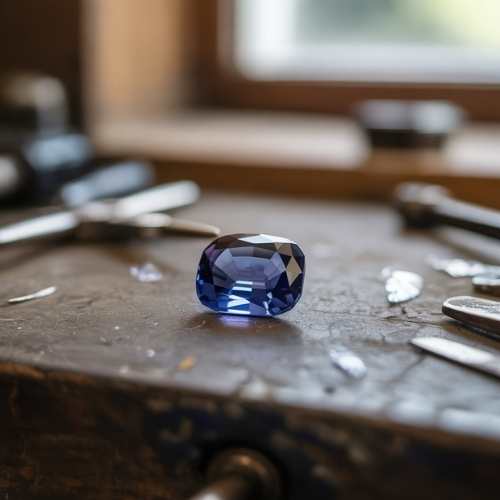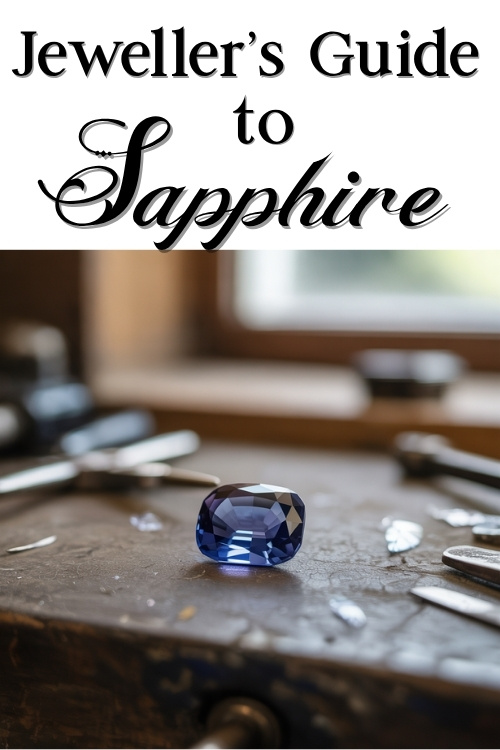Rich in elegance and steeped in myth, sapphire is one of the most iconic gemstones in the world. While its deep, velvety blues are the most recognised, sapphire also appears in nearly every colour of the rainbow, offering jewellers a remarkable palette to work with. Durable, versatile, and endlessly inspiring, this member of the Big Five is as practical as it is breathtaking.
Basic Identification Information
Name & Synonyms
Sapphire; known as fancy sapphire when not blue.
Species
Corundum
Colour Range
Blue, yellow, pink, green, purple, orange, white, grey, black, brown, and colourless.
(Any colour except Red)
Refractive Index
1.757–1.779
Birefringence
0.008–0.010
Optical Sign
Uniaxial −
Pleochroism
Weak to strong and 2 colours.
The colours vary by sapphire colour:
Blue: violet-blue and blue-green
Green: green and yellow-green.
Orange: yellow and brown or orange and colorless.
Yellow: yellow and pale yellow.
Purple: violet and orange.
Brownish Orange: Brownish orange and greenish.
Padparadscha: Orange-yellow and yellowish orange.
Specific Gravity
3.95–4.10
Fluorescence
None to strong
Lustre
Vitreous (glass-like)
Clarity (GIA Clarity Type)
Type II
Inclusions are common, though high-quality stones may appear eye-clean.
Gems Often Mistaken For
Iolite, Spinel, Topaz, Tanzanite
Mohs Hardness
9
Wearability
Excellent – ideal for all jewellery types, including everyday wear.
Birthstone
September
Spotting Synthetic (Lab-Grown) Sapphire
Lab-grown sapphires are chemically identical to natural stones. They can be difficult to distingish without magnification or gemmological tools.
However, the most obvious signs of synthetic sapphires is curved growth lines, curved striae, or gas bubbles, especially in stones created by flame fusion or flux methods. These features are not found in natural sapphires.
Common Treatments
Heat treatment is extremely common for sapphire and is accepted within the trade. It is used to improve both clarity and colour and is considered a stable and permanent enhancement that does not affect the gem’s durability.
Diffusion treatment is also used to alter or intensify sapphire’s colour. This process involves adding elements like titanium or chromium to the surface of the stone and heating it so that the colour change penetrates into the gem. Most diffusion-treated sapphires only show colour alteration on the outer layer, but newer beryllium diffusion methods can reach deeper into the stone and completely change its appearance. These deeper treatments can be difficult to detect and may affect value.
Fancy sapphires, particularly in vibrant colours, may also be irradiated or coated. These treatments are less stable and should be disclosed, as the colour can fade or change over time.
Durability & Setting Considerations
With a hardness of 9 and no cleavage, sapphire is one of the toughest gemstones available. It performs well in rings, pendants, earrings, and bracelets, and is more than capable of handling everyday wear.
That said, no gemstone is entirely immune to damage. Sharp impacts can cause chips or fractures, especially on exposed edges or corners.
In sapphires treated with surface diffusion, the colour layer can wear down over time, particularly in high-contact settings like rings.
Sapphire’s high heat tolerance makes it suitable for most benchwork, but it’s still best to remove the stone before soldering or casting to avoid heat-related damage to internal inclusions.
If the stone features colour zoning or interesting internal patterns, these can be used to your advantage by choosing a setting that enhances the gem’s natural character.
Care Instructions
Cleaning
Warm, soapy water and a soft brush are all you need to keep most sapphires looking their best. Ultrasonic and steam cleaners are generally safe for untreated or heat-treated sapphires, but should be avoided for stones that have been diffusion-treated or coated, as these methods could damage or dull the surface. Causion should also be taken with heavily included gems.
Storage
Store sapphires separately from harder stones like diamonds to avoid accidental scratching. Individual soft pouches works well for this purpose.
Daily Wear
Sapphire’s excellent durability makes it ideal for everyday wear, but it’s still worth removing rings or bracelets before doing anything that might involve hard knocks, such as lifting heavy items, gardening, or using tools.
Market & Ethical Notes
Sapphire has long been associated with luxury, and stones from certain origins are especially prized. Blue sapphires from Kashmir, Burma (Myanmar), and Sri Lanka are among the most sought after and can command premium prices for their velvety textures and intense colours.
Fancy sapphires, which come in every colour but red, tend to be more accessible in price. Their variety makes them especially popular for jewellers looking to create unique and expressive designs. Even bi-colour and colour-zoned stones, once considered less desirable, are gaining attention for their character and individuality.
Sapphire is mined in many parts of the world, with Sri Lanka, Madagascar, Australia, and Thailand among the most important sources. Ethical sourcing is becoming more of a priority for both jewellers and consumers. Mines in Sri Lanka and Australia, in particular, are known for having stronger environmental and labour standards. Increasingly, traceable supply chains and responsibly sourced stones are becoming part of the value proposition for modern jewellers.
Symbolic & Spiritual Meanings
Sapphire has long been considered a stone of wisdom, integrity, and focus. In both historical and metaphysical contexts, it is seen as a gem that promotes clarity of thought, loyalty, and protection from negative influences.
Blue sapphire is especially associated with calm, insight, and communication. It’s traditionally linked to the throat chakra, encouraging honest speech and confident self-expression.
Fancy sapphires in lighter or warmer colours, such as yellow and pink, are thought to carry joyful, creative, or emotionally uplifting qualities. Each hue is said to resonate with different aspects of the self, making sapphire a flexible and meaningful choice in spiritual and symbolic jewellery.
🔗 Dive deeper into Sapphire’s Symbolic & Spiritual Meanings
Etymology
The name “sapphire” comes from the Latin sapphirus and the Greek sappheiros, both likely referring to blue stones used in the ancient Mediterranean world. These terms may ultimately trace back to the Hebrew word sappir, meaning “precious stone.”
🔗Curious about how sapphire was viewed in ancient cultures? Explore its fascinating myths and legends (coming soon)
📌 Save this jeweller’s guide to sapphire for quick reference next time you’re working with this stunning gem.


